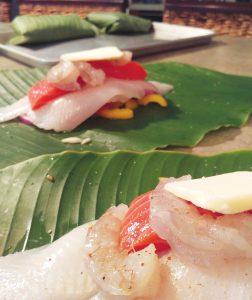 By Paul Suplee, MBA, CEC, PC-3
By Paul Suplee, MBA, CEC, PC-3
Spring is sprung, the grass is rizz (‘ris’?. I’ve never attempted to spell that one out), I wonder where the banana palms is.
So maybe my little ditty is not true to form, but you get the idea. Spring has definitely sprung and the flora abounds, mesmerizing me at every turn with the greens and pinks and blues and purples. For me, this is my favorite time of year, especially in my own backyard. It’s a time for love and rebirth and good energy. There is no better kickoff than spring in letting the sun shine down.
I love my yard this time of year with my grill, a flat top griddle and even a bonfire on which to cook. Of course, the latter is my favorite as long as I have some white post oak or hickory on hand, but cooking on any of these makes for a wonderful evening.
The banana palms come back every year, spreading their roots intricately underground during the colder months. Usually, they would be about a foot or two tall by this time, but because the winter was so mild, a few of them are already taller than me.
And what exactly does that mean for an old chef? Well, it means that I can start plucking the first of thousands of leaves to adorn my yard over the next six months and start cooking with them. An older El Salvadoran woman once taught me how to use them for tamales, something that I will definitely get into later this summer, and in Hawaii I was taught how to use them in Lau Lau and other dishes.
In the Caribbean, a chef showed me my favorite way to use banana leaves, and that was grilling (and in the process steaming) seafood wrapped in the leaves, akin to papillote which is the French style of wrapping food in parchment, creating its own little steam bath.
The joy of the banana leaves is that the banana flavor and essence cooks into the food if only just slightly. These trees never grow actual bananas, as they are a Japanese hybrid developed to withstand cold weather, but when you cut into a leaf or a stem you can smell the unmistakable aroma of our favorite potassium-laden delicacies.
When working with banana leaves, they can split as you work with them, and this can be quite problematic, as the goal is to keep as much of the moisture inside as possible. Two simple tricks that I learned over the years will make your life much easier. The first is to dunk the leaf in some hot water for about three seconds, or just enough to soften it.
The second trick is to pick leaves and freeze them. The freezing process breaks down the cells and softens the leaves, rendering them flaccid and ready, a contradiction that no middle-aged man should put in writing. But I digress.
Whichever technique you use to soften the leaves (if you even need to), you will be able to create a wide array of dishes. Now that I’m writing this, I believe that tamales could be in order next week as they are incredible. But, for now I will relish in Springtime, the season of young love and food from our gardens.
Thank you Spring for sprunging.
Local Catch in Banana Leaves
Serves 4
4 whole fresh banana leaves (or frozen
which I’ll explain later)
2 lb. Assorted fresh and high quality seafood
2 inches peeled and smashed ginger
4 ea. Cloves garlic, smashed and minced
1 stick unsalted, grass-fed butter
splash sesame oil per packet
4 ea. Spring onions, sliced
1 c. White wine
2 Tbsp. Soy sauce
2 Tbsp. Sugar in the raw, jaggery or brown sugar
2 Tbsp. Rice wine vinegar
Salt and Pepper, to taste
If the leaves are large, strip the rib out of the middle and use either side as your wrapper. If the leaves are somewhat small, you may have to leave them whole and lightly smash the rib to get the leaves nice and pliable. As the leaves get ‘older’ they get tougher. You may have to dip them in water over 140F to loosen them up a bit. Otherwise, they can simply shred apart.
After that, it’s all simple, or at least as simple as rolling a burrito.
Top the leaf with some seafood and the remaining ingredients.
Look up a burrito-wrapping video, and follow those instructions to the T. I honestly would not have enough words left to describe how to do it.
The beauty of the banana leaves is twofold. It adds an unduplicable flavor to the food, and it acts as a protective barrier to your precious seafood, as follows in the next step.
Heat a grill and cook the seafood until it is cooked through. It is quite similar to the old French technique en papillote but with actual flavor, an insult I write with a modicum of chagrin considering my own lineage.
When the leaves are properly scorched, and the seafood is cooked through, merely serve them as they are. Serve with a salad or grilled vegetables. Frankly, I don’t care. Just serve them as they are and afford your guests the privilege of opening up their special packages to enjoy. There is little in the culinary world to compare to it.
Paul Suplee is the owner of the boxcar restaurants
and is also Senior Lecturer of Culinary Arts at UMES.
boxcarrestaurants.com
